This article discusses the price fluctuations of BTC during the election period, pointing out that the BTC price is closely related to Trump's chances of winning. The short-term rise has been overestimated, and the actual upward trend has already occurred. The value of BTC as an inflation hedge asset will gradually emerge, and it is believed that the price change after Trump's victory will not be significant, and the long-term rise of BTC will occur in 2025/2026.
The original content is as follows (the original content has been edited for easier reading):
Series Analysis of Today's Election Results
First, we start with an analysis of the betting market odds that are currently driving the BTC price trend. For reference: at the time of this post (14:02 UTC), Trump's winning odds are 61.7%, and the BTC price is $70,047.38.

Relationship between BTC Price Trend and Trump's Winning Odds
I will first compare the relationship between the BTC price trend and Trump's winning odds, assuming that the BTC price fluctuations over the past few weeks are entirely based on Trump's chances of winning. Next, I will divide these price trends into four different stages.
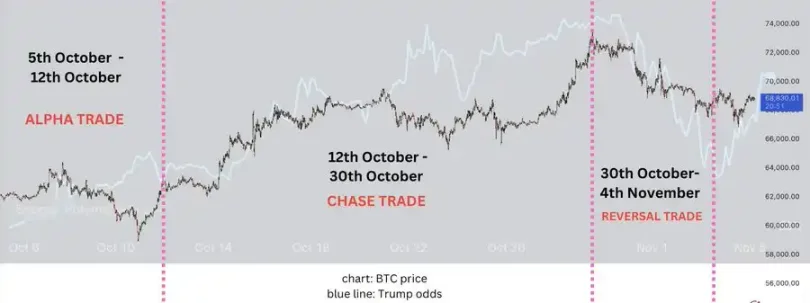
October 5 - October 12: Emerging Opportunity
During this week, the mindset of market participants began to change:
Trump's probability of winning (slowly rising to over 50% in the betting market) is not zero. In fact, the election situation looks closer than expected (especially after Biden's retirement). This initial realization had an impact: market participants began to hedge against a Harris victory or re-evaluate their previous biases.
By comparing the two baskets GSP24DEM and GSP24REP, we can clearly see that after the Harris-Trump debate, the market's confidence in a Harris victory was once overly complacent.

The market not only expressed complacency about the outcome, but also severely misjudged the possibility of a Trump victory. In the almost complete absence of attention to the election situation in August and September, the market was almost completely priced for a Harris victory.
Therefore, the following occurred:
1. More than 75% of people believed that the probability of a Harris victory was very high
2. Almost no one focused on hedging a Trump victory, everyone was focused on hedging index risks
3. The betting market began to suddenly tilt towards Trump
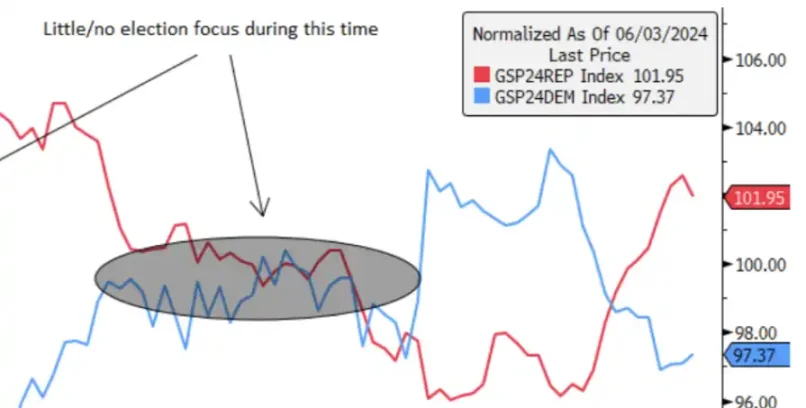
Another noteworthy event occurred in the traditional financial market at that time, which can help better understand the speed of the change in sentiment. In the first stage (October 5 - October 12), the demand for index-level hedging was very high. This means that everyone believed that the market index (such as the S&P 500, Nasdaq) might experience a significant decline.[Remember the Iran situation?]
As a result, investors rushed to buy index hedges to avoid suffering a huge "explosive" impact. However, whenever there is a large amount of index hedging without the actual risk materializing, the "painful trade" often reverses upwards. So the market started to rise. The worst-case conflict scenario (such as Iran and Israel) did not occur, and the market sentiment also calmed down.

The "Fear, Uncertainty and Doubt (FUD)" in the Middle East is not insignificant, although the crypto Twitter (CT) seems to have downplayed its impact. During this one-week period, the premium for index hedging reached an unprecedented high, and the investors' anxiety caused them to focus almost all their attention on the risk of index decline, and they were almost indifferent to the "yet to come" election.
This reversal of sentiment did not occur when oil prices peaked in early October (check the image: oil price pressure), but in late October. The Trump/election trade began when investors were fully focused on index risk (check BTC's strong performance on October 10), not just recently.
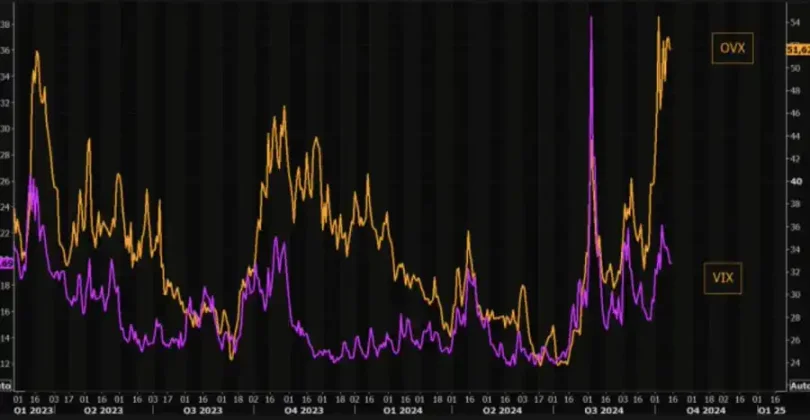
The above content is to help readers understand the theme of the period from October 5 to October 12, why everyone's attention to this trade was lacking, why the "Trump trade" became such an important dominant theme, and why there were ultimately no buyers to take over the profit-taking.
In summary: the index risk brought by the Middle East situation provided a good buying opportunity for those willing to challenge the panic sentiment, and the "Trump trade" was thus initiated. The complacent sentiment for a Harris victory began to reverse, and the market focus shifted to the Middle East FUD.
Then, an event occurred: the Trump-sensitive stocks experienced the most hated rebound, driven by "no one having the right tail risk" and the mean reversion of Trump. BTC reacted more slowly to this change in sentiment, we were one of the last assets to follow the change, along with the Trump media (a bit like MEME stocks), rising with the increase in Trump's winning probability, (the actual stock basket adjusted faster, most Republican stocks had already adjusted by early October.) Mean reversion is happening.
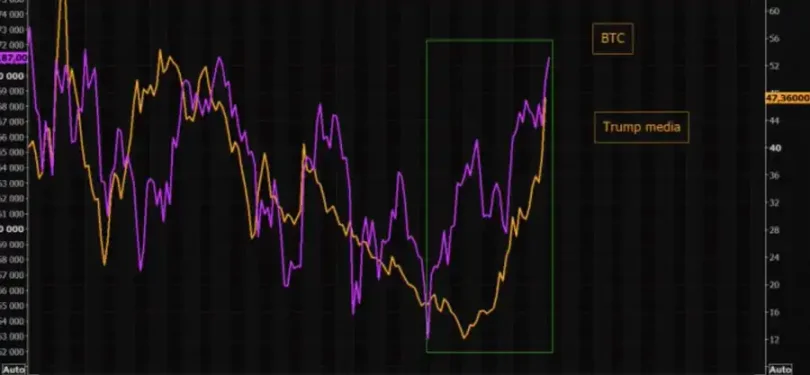
BTC began to show strength from the last retracement on October 10, as market participants realized that the election trade had begun, and the entire market is now in a "risk-on" state.
October 12 - October 30: Chasing the Rally
The accumulation of Bitcoin during this 18-day window period while waiting for the election results has been simply crazy. This rebound is basically a one-way upward trend, with short sellers being mocked and all pullbacks being completely swallowed up. ETF inflows have hit new highs. It's a completely bullish environment.
But why is this the case? Is it Saylor's forward-looking trading? Actually, no, MSTR's announcement has hardly caused any volatility - it's all due to the election trade, nothing else. Apart from the rising probability of a Trump victory, there are no other factors (such as interest rates or inflation) that could provide buyers with such a chasing signal.
During those few days, the market was rising almost daily, with geopolitical risks and Nasdaq's weakness being completely ignored (e.g. on October 15, the divergence between Nasdaq and Bitcoin). The entire market performance was a big green candle. All of this is closely related to Trump's probability of winning. Trump-sensitive stocks were heavily bought, and Bitcoin also rose accordingly.
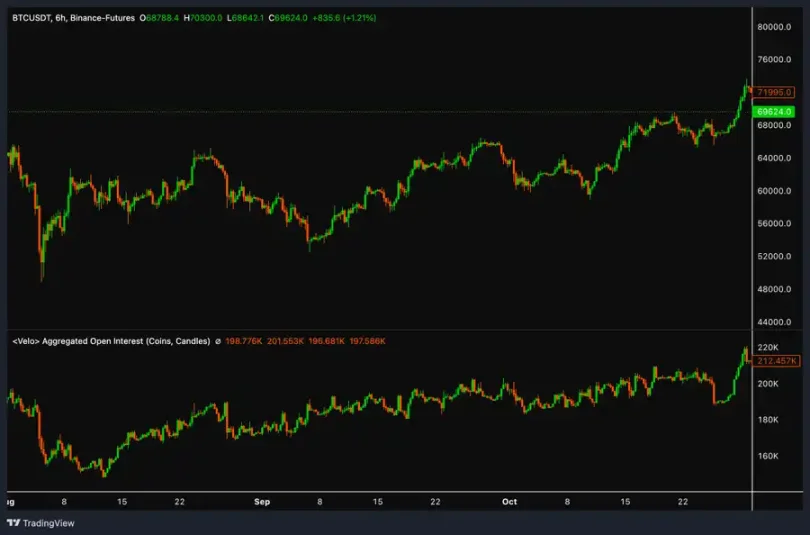
We've been chasing the price, with open interest (OI) constantly increasing, and even though the lead in perpetual contracts is very large, Bitcoin has continued to rise without a violent pullback, even as Nasdaq has been weak. For example, around October 17, the price of 67K remained stable for a while, and then the spot market followed slightly, but there was no significant pullback. This indicates that there is not only short-term leverage liquidation demand in the market, but also actual demand supporting the uptrend. This also implies that this rally is event-driven, with investors hoping to get in at this time.
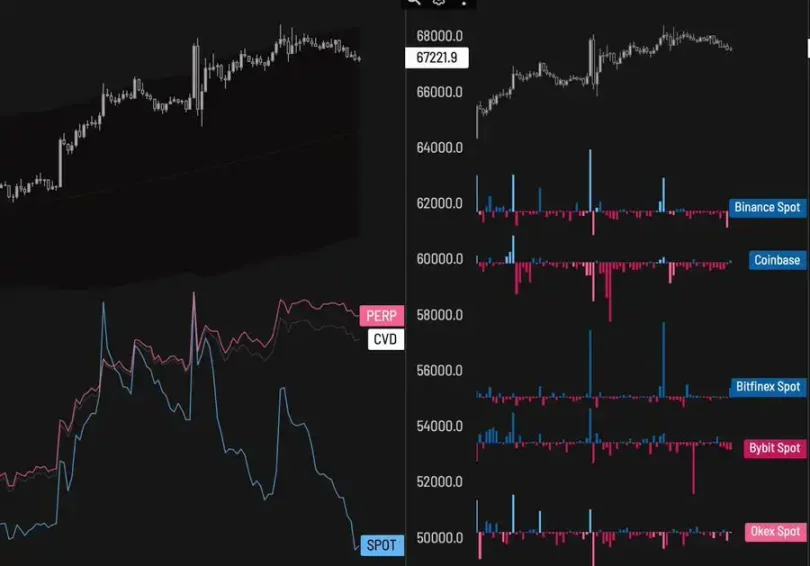
Around October 14, the market shifted from "we haven't properly considered the probability of Trump winning" to "Trump seems to be winning, now we need to chase the rally". That week, the performance of the macro market clearly showed Trump trade-related characteristics, especially in the nuclear energy and commercial real estate sectors, which rose along with Bitcoin-sensitive stocks. Clearly, this rally was not accidental, but the result of the Trump trade. The true core of this market movement occurred that week, and any subsequent rallies were just speculative capital betting on the short-term outcome.

After several consecutive days of gains, a turning point finally occurred. October 30 - November 4: During the reversal trading period, the Bitcoin price was highly correlated with the probability of a Trump victory. For the first time since October 10, the market did not easily absorb the pullback as it had in the past. Although prices hit new highs, technical factors (such as the improvement in open interest OI) did not change much, but the market became hesitant.
This hesitation is due to the decline in the probability of a Trump victory, not the so-called "resolution of election risk". For example, the S&P 500 and Nasdaq 100 indices rose 1% and 1.2% respectively, but this was not due to the resolution of election risk, but rather the decline in Trump's probability of winning, leading to significant selling. This correlation was unimaginable a few months ago, and the supply held by market participants with election bets is now so large that it completely dominates the price trend.
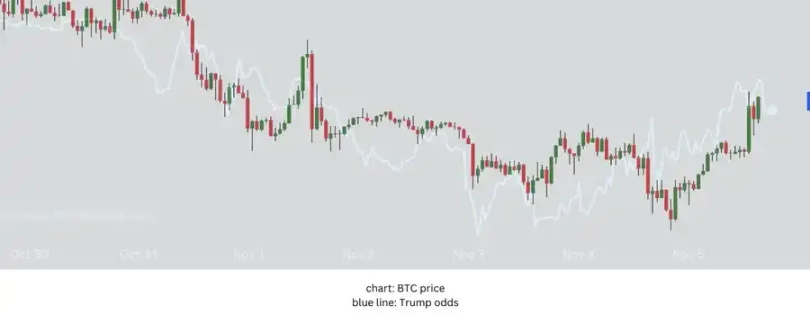
Why is Trump's victory - if it is now so important to Bitcoin's price trend - not pushing Bitcoin above $80,000? Currently, every small price fluctuation is related to Trump's probability of winning, but why would Trump's victory not directly drive Bitcoin higher?
Who will be the next buyer? Why? Who will come out and say "yes, now is a good time to buy a lot of Bitcoin" after Trump's victory? Of course there will be buyers, but will they exceed those investors who have already accumulated Bitcoin for more than a month, and who are ready to take profits once their bet is successful? The answer is no.
After Trump's victory, we may see the entire rally retrace. So what short-term incentives are there to drive people to buy Bitcoin now? Will Trump announce the establishment of a sovereign Bitcoin fund on Inauguration Day? No. What other policies need to change? The US is already moving in a Bitcoin-friendly direction. How many times did Trump mention Bitcoin or cryptocurrencies during his campaign, especially compared to issues like immigration? None.
So there won't be much change in the short term, and people are now facing a window of over 2 months (until January 20th when Trump officially takes office), and after that, it may take a long time to see real changes.
Traders won't bet on something that might happen at least 2 months from now, so buying Bitcoin now is not a bet on Trump's presidency, but on the upcoming election result. The 40% probability of a Harris victory makes the current appeal of longing Bitcoin less attractive, because you still face a large amount of short-term supply selling. If the upside is assumed to be a 60% probability of winning $4, and a 40% probability of losing $10, then from a risk/reward perspective, the appeal of going long is not great. So many people forget that this election market is more like a "mowing field" full of short-term capital.
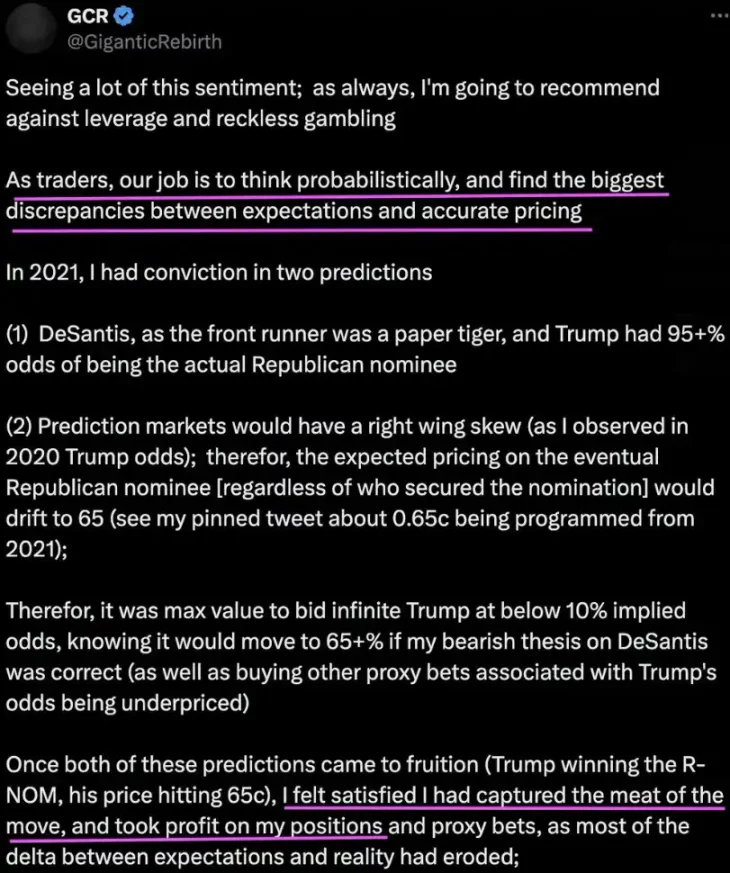
My Bitcoin price forecast summary: Trump victory: Initial excitement, may surge to new highs, but lacks support around $70k, then retraces, savvy holders will buy Bitcoin as an inflation hedge. Harris victory: 1 month of failed "pre-betting" on a Trump victory, sees a significant sell-off, more savvy holders will buy the supply, and the price will gradually rise back to new highs as an inflation hedge.
I believe the election outcome is not important, I am bullish on Bitcoin, believing it is an inflation hedge, but the short-term price volatility has been overly exaggerated, and the core of the market movement has already occurred.








